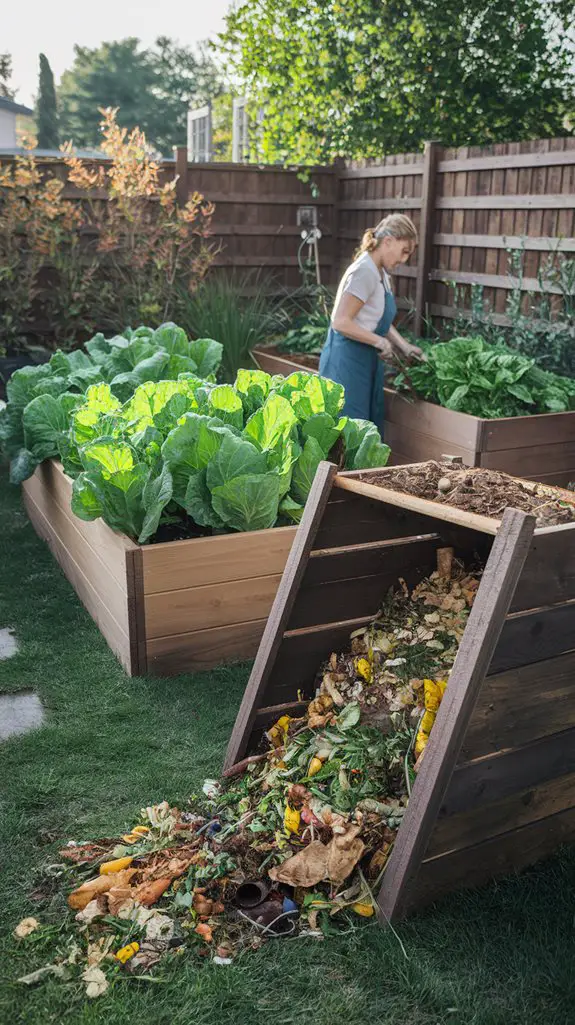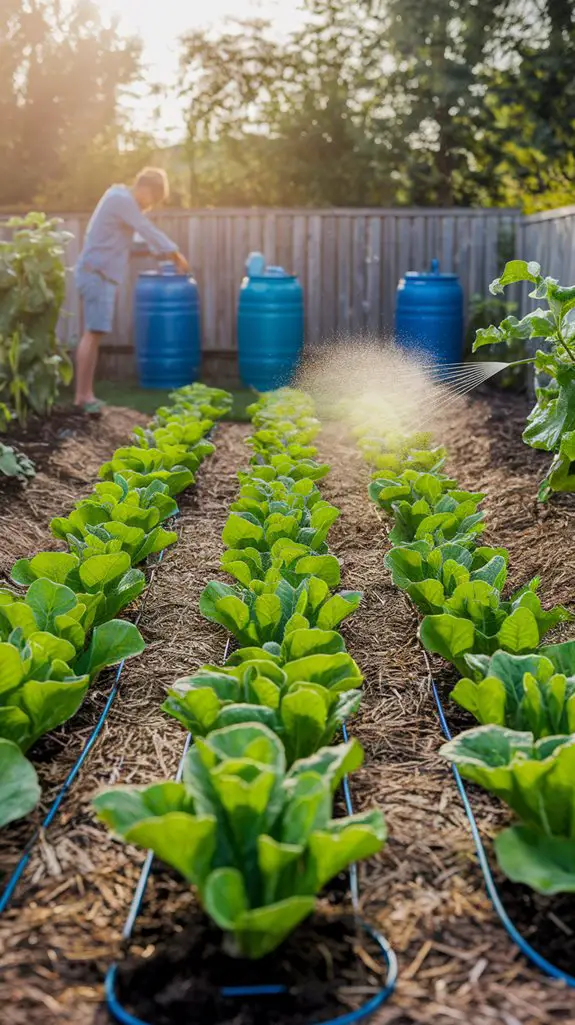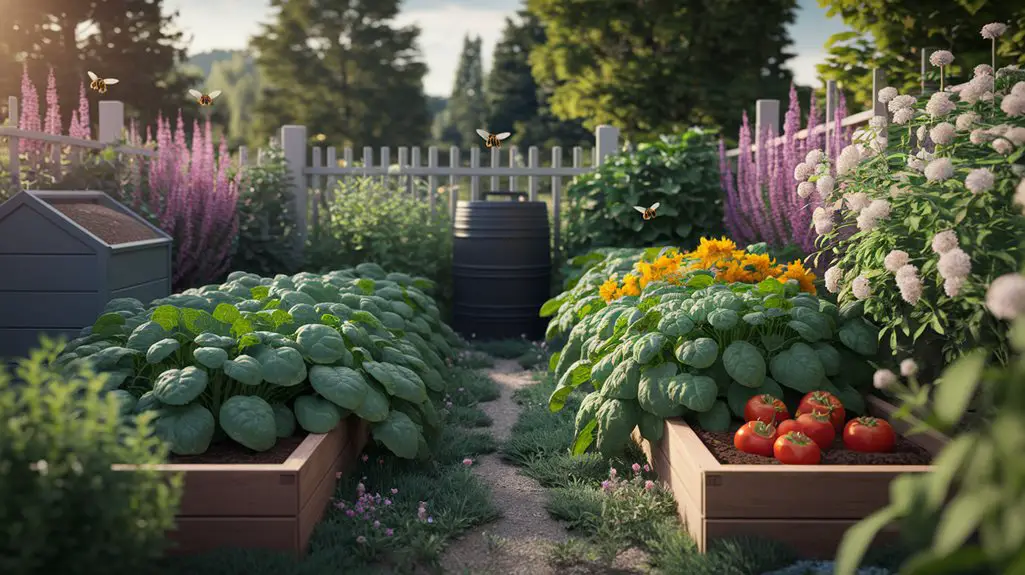Just as Thoreau found self-reliance at Walden Pond, you’ll discover true sustainability in your backyard vegetable patch. You’re creating a microcosm of environmental stewardship each time you plant a seed in your garden. When you grow your own food, you’re eliminating transportation emissions, preserving biodiversity, and closing the loop on organic waste through composting. The sustainability benefits extend far beyond the vegetables you’ll harvest—they reach into the very soil beneath your feet.
Reducing Carbon Footprint Through Local Food Production
When you plant vegetables in your backyard garden, you’re taking a significant step toward reducing your household’s carbon footprint.
Commercial produce typically travels 1,500-2,500 miles before reaching your plate, consuming substantial fossil fuels in transportation, refrigeration, and packaging.
Your homegrown vegetables eliminate these transportation emissions entirely. Each pound of locally grown produce saves approximately 2 pounds of CO₂ from entering the atmosphere.
Additionally, you’ll avoid the carbon costs associated with commercial fertilizers and pesticides when you opt for organic gardening methods.
Maximize your garden’s carbon-reducing potential by composting kitchen scraps, collecting rainwater, and choosing native varieties adapted to your climate. Creating your own sustainable herb garden can also enhance biodiversity and provide additional fresh ingredients for cooking.
These practices create a closed-loop system that minimizes resource inputs while providing fresh, nutritious food steps from your kitchen.
Composting and Organic Waste Management

Composting provides the foundation for sustainable waste management in your backyard garden, transforming kitchen scraps and yard waste into nutrient-rich soil.
You’ll create a closed-loop system when you collect vegetable peelings, coffee grounds, eggshells, and garden trimmings in a designated compost bin or pile.
Maintain proper compost health by balancing “green” nitrogen-rich materials with “brown” carbon-rich items like dry leaves or shredded paper.
Turn your pile weekly to accelerate decomposition and keep odors at bay. In 3-6 months, you’ll have dark, crumbly compost that improves soil structure, enhances water retention, and reduces the need for chemical fertilizers.
This practice diverts waste from landfills where it would generate methane, a potent greenhouse gas, while simultaneously enriching your garden with essential nutrients. Additionally, sustainable waste management through composting can significantly reduce your carbon footprint and promote biodiversity in your garden ecosystem.
Water Conservation Techniques for Home Gardeners

Water conservation stands as an essential practice for sustainable backyard vegetable gardening, especially as climate change increases drought frequency and water scarcity concerns.
You’ll maximize efficiency by implementing drip irrigation systems that deliver water directly to plant roots, reducing evaporation by up to 60% compared to sprinklers.
Collect rainwater in barrels positioned under downspouts to capture free, chemical-free water.
Apply 2-3 inches of organic mulch around plants to retain soil moisture and suppress water-stealing weeds.
Consider grouping plants with similar water requirements together, a practice called hydrozoning.
Early morning watering (5-9am) minimizes evaporation while giving foliage time to dry, preventing fungal diseases.
Finally, incorporate drought-resistant varieties and native plants that thrive with minimal irrigation, ultimately creating a garden that’s both productive and water-wise. Additionally, implementing permaculture principles can further enhance your garden’s sustainability by creating a self-sustaining ecosystem.
Heirloom Seeds and Biodiversity Preservation
The preservation of biodiversity through heirloom seed cultivation represents a cornerstone of truly sustainable vegetable gardening. When you grow heirloom varieties, you’re participating in a centuries-old tradition of seed-saving that maintains genetic diversity in our food supply. Additionally, growing your own food in an urban setting can significantly reduce food transportation emissions, making your gardening efforts even more impactful.
| Heirloom Type | Benefits | Saving Technique |
|---|---|---|
| Tomatoes | Disease resistance, unique flavors | Fermentation method |
| Beans | Drought tolerance, nitrogen-fixing | Dry completely on vine |
| Squash | Climate adaptability, long storage | Cure seeds before storing |
Select open-pollinated varieties that have been grown for at least 50 years, adapting to local conditions over generations. By saving these seeds annually, you’ll develop plants perfectly suited to your microclimate while reducing dependence on commercial seed sources and preserving agricultural heritage for future generations.
Chemical-Free Pest Control Methods
Effective pest control without synthetic chemicals forms the foundation of a truly sustainable backyard vegetable garden.
You’ll find companion planting particularly valuable—marigolds deter nematodes while nasturtiums attract aphids away from your crops.
Install physical barriers like floating row covers to block cabbage moths and cutworm collars to protect seedlings.
Encourage beneficial predators by planting diverse flowering herbs that attract ladybugs, lacewings, and parasitic wasps.
These natural allies consume destructive pests like aphids and caterpillars.
For immediate intervention, deploy homemade remedies such as garlic-pepper spray or neem oil solutions that disrupt pest life cycles without harming beneficial insects.
Remember that healthy soil produces resilient plants that naturally resist pests.
Regular crop rotation disrupts pest patterns while biodiversity creates a self-regulating ecosystem in your garden. Additionally, utilizing natural pest solutions can enhance your garden’s pest management strategy.
Maximizing Small Spaces With Vertical Gardening
Limited square footage needn’t restrict your gardening ambitions when you embrace vertical growing techniques. Utilize trellises, wall-mounted planters, and stackable containers to transform unused vertical space into productive growing areas.
Install cattle panels or sturdy lattice for vining crops like cucumbers, pole beans, and peas, allowing them to climb rather than sprawl.
Repurpose pallets as vertical herb gardens or mount rain gutters in tiers for leafy greens. Employ hanging baskets for cherry tomatoes and strawberries, positioning them where they’ll receive adequate sunlight.
Consider wall-mounted pocket planters for compact herbs and microgreens. Vertical gardening techniques can help you maximize your efforts and yield in limited spaces.
When planning your vertical garden, verify your structures can support plants at maturity and facilitate easy watering and harvesting.
You’ll double or triple your growing space while creating an aesthetically pleasing garden environment.
Season Extension Strategies for Year-Round Harvests
Many backyard gardeners miss opportunities for year-round harvests because they only plant during traditional growing seasons. You can greatly extend your growing period with a few practical strategies.
Install cold frames or low tunnels to protect cool-weather crops like spinach and kale during early spring and late fall. For winter growing, consider a greenhouse or hoop house that captures solar energy. Use row covers to shield tender plants from frost, adding 4-6 weeks to both ends of your season.
Succession planting—sowing new crops every 2-3 weeks—ensures continuous harvests. Choose season-appropriate varieties like heat-tolerant lettuce for summer and frost-hardy Brussels sprouts for winter.
Don’t overlook winter gardening; many root vegetables and brassicas actually improve in flavor after light frosts.
Building Healthy Soil Through Natural Amendments
Healthy soil forms the foundation of any successful vegetable garden, yet most beginner gardeners underestimate its importance. You’ll achieve greater yields and disease resistance by incorporating natural amendments that build soil structure and fertility.
Start by adding compost—create your own from kitchen scraps, yard waste, and fallen leaves. It’s nature’s perfect soil enhancer, improving both drainage and water retention.
Consider incorporating worm castings, which introduce beneficial microorganisms while providing slow-release nutrients.
Cover crops like clover, rye, and buckwheat prevent erosion, add organic matter, and fix nitrogen when turned under.
Sprinkle crushed eggshells for calcium, coffee grounds for nitrogen, and wood ash for potassium.
Remember to avoid synthetic fertilizers that harm soil biology. Instead, brew compost tea by steeping finished compost in water to create a nutrient-rich soil drench. Additionally, using organic materials can significantly enhance microbial activity and nutrient availability in your garden soil.
Conclusion
Your backyard garden isn’t just providing fresh produce—it’s creating a sustainable ecosystem. By implementing techniques like rainwater harvesting and composting, you’ll dramatically reduce your environmental impact. Consider the case of Seattle’s Urban Garden Project, which documented a 65% reduction in participating households’ food-related carbon emissions. Start with one sustainable practice today, and you’ll contribute to a healthier planet while enjoying the rewards of homegrown vegetables.




